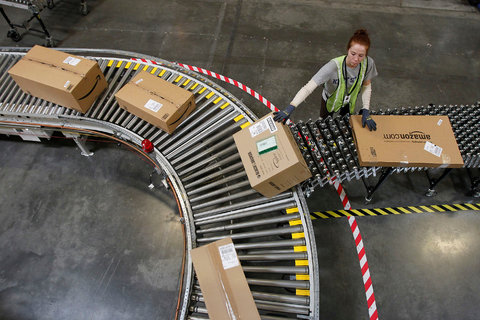Tech News


For all of the noise and hype — drones! one-hour delivery! get more toilet paper painlessly! — e-commerce is showing the first signs of maturing as a business. Figures from the research firm eMarketer show the rate of domestic growth falling from 16.5 percent in 2013 to 14.2 percent this year to 11.6 percent in 2018. By that point, e-commerce in the United States will still be less than 10 percent of all retail. The death of the physical store, so widely anticipated in the last few years, is nowhere in sight.
“Not a lot of new e-commerce users in the U.S. these days,” said Dan Marcec, a spokesman for eMarketer. “Plus, we still love to shop and buy in stores. Retailers are trying to leverage mobile usage not only to push mobile commerce, but also (and maybe even more aggressively) to get people information to encourage buying in-store.”
That was one theme of the 11th annual Internet Retailer Conference and Exhibition, held in Chicago this week. People who make stuff were once content to let someone else sell it for them online. Now they increasingly realize they will be much better off capturing the customer themselves. The benefits: They retain more margin without a middleman. They have tighter control over packaging and shipping — the box promotes them, not the retailer. And, most important, they have the name and email address of someone who likes their stuff.
The problem, of course, is how to get that customer coming to the brand’s site in the first place. The whole point of Amazon or Overstock or eBay is that one account means one-stop shopping. Amazon Prime, which has tens of millions of customers for its $100-a-year shipping program, is doing all it can to build an ecosystem where the exit doors are impossible to find.
“Amazon is driving more people to buy online,” said Amy Heidersbach of Needle, a customer engagement platform with a big exhibit at IRCE. “That’s good for everyone selling online. But the problem is how do you compete, and not just be a showroom for Amazon?”
Amazon is not only the dominant figure in e-commerce but probably the most aggressive. It does not exhibit at IRCE, but it is never far from the mind of attendees — even those who did not attend the full-day convention workshop, “Amazon & Me.” Among the panels: “What all retailers need to know to compete against or cooperate with Amazon.”
“Sellers want to feed from every pond, and Amazon is not just a pond, it’s an ocean. Leaving it would not be a good idea,” said Eitan Zimerman of Act Bold Media Group, a consultant shop. “But developing some alternatives is.”
The alternatives begin at home. Amazon or another web merchant might charge a 15 percent fee for selling something. That gives the brand a few dollars to potentially pass on to the customer. One increasingly popular technique: allowing the customer to name his price.
Under a Coffee and Bacon Station sign, members of PriceWaiter, a Chattanooga, Tenn., start-up, were doling out snacks and explaining how letting customers of a website decide how much they are willing to pay (within, to be sure, a narrow range) works out for both parties. “The merchants win by keeping the sale, and the customer gets a psychological victory — it feels like a win,” said Brian Sibley.
Another customer retention method, this one somewhat more fraught with peril: Put reviews on your site. This, of course, is an attempt to take away or at least neutralize one of the features that drove Amazon’s initial success. “Reviews instill trust in your brand and keep the customer coming back,” said Alex Rosen of PowerReviews, a back-end platform to making reviewing easier. He added that brands like to know, must know, when they are getting bad reviews. But strong indeed is the brand that will keep bad reviews on its own site.
If many of the exhibitors at IRCE were trying to avoid Amazon, a few were taking it on directly. Justin Singletary said he spent $500,000 a few years ago to buy the Fulfillment.com web domain from eBay. “We saw a void in the marketplace — an opening to take care of the merchants themselves rather than the merchant’s customers,” he said. Asked who the merchants were, he demurred, saying they operated under nondisclosure agreements.With about 60 employees and one domestic warehouse, Fulfillment.com is still an early-stage start-up.
Newegg, founded way back in 2001, is by comparison practically an institution. It says it is the second-largest online retailer in North America, with 28 million registered customers, about a tenth of Amazon’s. “Amazon wants to do everything,” said a spokeswoman, Claire Lin. “We want to be really good at one thing: selling tech products.”
Amazon and Overstock and eBay and Google would presumably answer that they want to be good at selling everything. Which leads to the final realization of the convention, an inescapable lesson for the Age of Twitter and Facebook: Big or small, you gotta blow your own horn these days.
“Look at Apple,” said Mr. Zimerman, the consultant. “Everything about them is bold. It has the most aggressive marketing. It is always in the news. Brands are constantly pushing, constantly revealing. No one just sits back and watches anymore. Take Blackberry. They had the business mobile market and sat back and got swallowed up.”
source:http://bits.blogs.nytimes.com/2015/06/05/selling-e-commerce-while-avoiding-amazon/?ref=technology&_r=0

